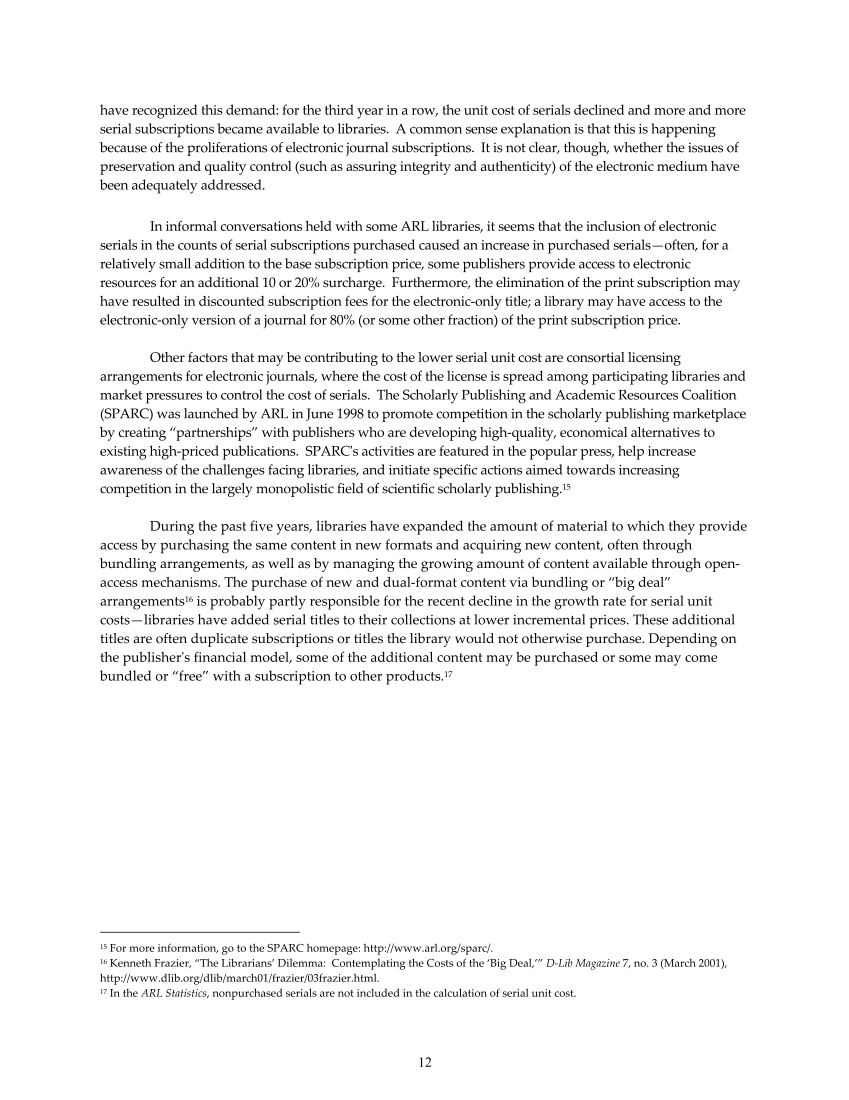12
have recognized this demand: for the third year in a row, the unit cost of serials declined and more and more
serial subscriptions became available to libraries. A common sense explanation is that this is happening
because of the proliferations of electronic journal subscriptions. It is not clear, though, whether the issues of
preservation and quality control (such as assuring integrity and authenticity) of the electronic medium have
been adequately addressed.
In informal conversations held with some ARL libraries, it seems that the inclusion of electronic
serials in the counts of serial subscriptions purchased caused an increase in purchased serials—often, for a
relatively small addition to the base subscription price, some publishers provide access to electronic
resources for an additional 10 or 20% surcharge. Furthermore, the elimination of the print subscription may
have resulted in discounted subscription fees for the electronic‐only title a library may have access to the
electronic‐only version of a journal for 80% (or some other fraction) of the print subscription price.
Other factors that may be contributing to the lower serial unit cost are consortial licensing
arrangements for electronic journals, where the cost of the license is spread among participating libraries and
market pressures to control the cost of serials. The Scholarly Publishing and Academic Resources Coalition
(SPARC) was launched by ARL in June 1998 to promote competition in the scholarly publishing marketplace
by creating “partnerships” with publishers who are developing high‐quality, economical alternatives to
existing high‐priced publications. SPARCʹs activities are featured in the popular press, help increase
awareness of the challenges facing libraries, and initiate specific actions aimed towards increasing
competition in the largely monopolistic field of scientific scholarly publishing.15
During the past five years, libraries have expanded the amount of material to which they provide
access by purchasing the same content in new formats and acquiring new content, often through
bundling arrangements, as well as by managing the growing amount of content available through open‐
access mechanisms. The purchase of new and dual‐format content via bundling or “big deal”
arrangements16 is probably partly responsible for the recent decline in the growth rate for serial unit
costs—libraries have added serial titles to their collections at lower incremental prices. These additional
titles are often duplicate subscriptions or titles the library would not otherwise purchase. Depending on
the publisherʹs financial model, some of the additional content may be purchased or some may come
bundled or “free” with a subscription to other products.17
15 For more information, go to the SPARC homepage: http://www.arl.org/sparc/.
16 Kenneth Frazier, “The Librarians’ Dilemma: Contemplating the Costs of the ‘Big Deal,’” D‐Lib Magazine 7, no. 3 (March 2001),
http://www.dlib.org/dlib/march01/frazier/03frazier.html.
17 In the ARL Statistics, nonpurchased serials are not included in the calculation of serial unit cost.
have recognized this demand: for the third year in a row, the unit cost of serials declined and more and more
serial subscriptions became available to libraries. A common sense explanation is that this is happening
because of the proliferations of electronic journal subscriptions. It is not clear, though, whether the issues of
preservation and quality control (such as assuring integrity and authenticity) of the electronic medium have
been adequately addressed.
In informal conversations held with some ARL libraries, it seems that the inclusion of electronic
serials in the counts of serial subscriptions purchased caused an increase in purchased serials—often, for a
relatively small addition to the base subscription price, some publishers provide access to electronic
resources for an additional 10 or 20% surcharge. Furthermore, the elimination of the print subscription may
have resulted in discounted subscription fees for the electronic‐only title a library may have access to the
electronic‐only version of a journal for 80% (or some other fraction) of the print subscription price.
Other factors that may be contributing to the lower serial unit cost are consortial licensing
arrangements for electronic journals, where the cost of the license is spread among participating libraries and
market pressures to control the cost of serials. The Scholarly Publishing and Academic Resources Coalition
(SPARC) was launched by ARL in June 1998 to promote competition in the scholarly publishing marketplace
by creating “partnerships” with publishers who are developing high‐quality, economical alternatives to
existing high‐priced publications. SPARCʹs activities are featured in the popular press, help increase
awareness of the challenges facing libraries, and initiate specific actions aimed towards increasing
competition in the largely monopolistic field of scientific scholarly publishing.15
During the past five years, libraries have expanded the amount of material to which they provide
access by purchasing the same content in new formats and acquiring new content, often through
bundling arrangements, as well as by managing the growing amount of content available through open‐
access mechanisms. The purchase of new and dual‐format content via bundling or “big deal”
arrangements16 is probably partly responsible for the recent decline in the growth rate for serial unit
costs—libraries have added serial titles to their collections at lower incremental prices. These additional
titles are often duplicate subscriptions or titles the library would not otherwise purchase. Depending on
the publisherʹs financial model, some of the additional content may be purchased or some may come
bundled or “free” with a subscription to other products.17
15 For more information, go to the SPARC homepage: http://www.arl.org/sparc/.
16 Kenneth Frazier, “The Librarians’ Dilemma: Contemplating the Costs of the ‘Big Deal,’” D‐Lib Magazine 7, no. 3 (March 2001),
http://www.dlib.org/dlib/march01/frazier/03frazier.html.
17 In the ARL Statistics, nonpurchased serials are not included in the calculation of serial unit cost.


















































































































































